| Article ID | Journal | Published Year | Pages | File Type |
|---|---|---|---|---|
| 5135519 | Journal of Chromatography A | 2017 | 8 Pages |
â¢Structured γ-CD-MOFs as stationary phase was used for drug loading and retention.â¢High correlation between retention and drug loading was observed for γ-CD-MOFs.â¢New method is highly efficient to the conventional ways of drug loading into MOFs.
Drug loading into γ-cyclodextrin-metal organic frameworks (γ-CD-MOFs) using the impregnation approach is a laborious process. In this study, a γ-CD-MOF construct (2-5 μm particle diameter) was used as the stationary phase under HPLC conditions with the aim to correlate retention properties and drug loading capability of the CD-based structure. Ketoprofen, fenbufen and diazepam were chosen as model drugs with m-xylene as a control analyte to investigate the correlation of drug loading and their chromatographic behaviour in the γ-CD-MOF column. Furthermore, γ-CD itself was also prepared as the stationary phase by coupling with silica in the column to illustrate the enhanced interaction between drugs and γ-CD-MOF as a reference. The retention and loading efficiency of the drugs were determined with different ratios of hexane and ethanol (10:90, 20:80, 50:50, 80:20, 90:10, v/v) at temperatures of 20, 25, 30 and 37 °C. With the increment in hexane content, the loading efficiency of ketoprofen and fenbufen increased from 2.39 ± 0.06% to 4.38 ± 0.04% and from 5.82 ± 0.94% to 6.37 ± 0.29%, respectively. The retention time and loading efficiency of ketoprofen and diazepam were the lowest at 30 °C while those of fenbufen had the different tendency. The excellent relation between the retention and loading efficiency onto γ-CD-MOF could be clearly observed through mobile phase and temperature investigation. In conclusion, a highly efficient chromatographic method has been established to evaluate the drug loading capability of γ-CD-MOF.
